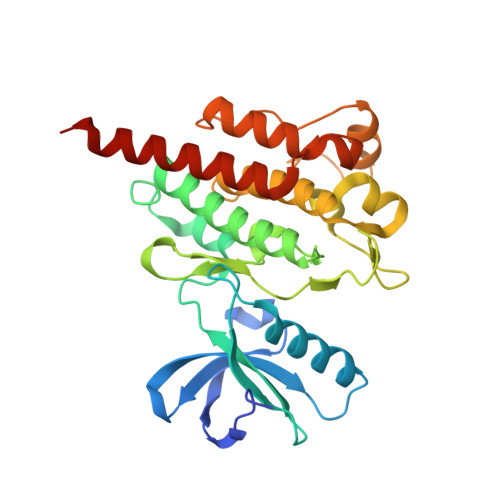Axitinib effectively inhibits BCR-ABL1(T315I) with a distinct binding conformation.
Pemovska, T., Johnson, E., Kontro, M., Repasky, G.A., Chen, J., Wells, P., Cronin, C.N., McTigue, M., Kallioniemi, O., Porkka, K., Murray, B.W., Wennerberg, K.(2015) Nature 519: 102-105
- PubMed: 25686603
- DOI: https://doi.org/10.1038/nature14119
- Primary Citation of Related Structures:
4TWP, 4WA9 - PubMed Abstract:
The BCR-ABL1 fusion gene is a driver oncogene in chronic myeloid leukaemia and 30-50% of cases of adult acute lymphoblastic leukaemia. Introduction of ABL1 kinase inhibitors (for example, imatinib) has markedly improved patient survival, but acquired drug resistance remains a challenge. Point mutations in the ABL1 kinase domain weaken inhibitor binding and represent the most common clinical resistance mechanism. The BCR-ABL1 kinase domain gatekeeper mutation Thr315Ile (T315I) confers resistance to all approved ABL1 inhibitors except ponatinib, which has toxicity limitations. Here we combine comprehensive drug sensitivity and resistance profiling of patient cells ex vivo with structural analysis to establish the VEGFR tyrosine kinase inhibitor axitinib as a selective and effective inhibitor for T315I-mutant BCR-ABL1-driven leukaemia. Axitinib potently inhibited BCR-ABL1(T315I), at both biochemical and cellular levels, by binding to the active form of ABL1(T315I) in a mutation-selective binding mode. These findings suggest that the T315I mutation shifts the conformational equilibrium of the kinase in favour of an active (DFG-in) A-loop conformation, which has more optimal binding interactions with axitinib. Treatment of a T315I chronic myeloid leukaemia patient with axitinib resulted in a rapid reduction of T315I-positive cells from bone marrow. Taken together, our findings demonstrate an unexpected opportunity to repurpose axitinib, an anti-angiogenic drug approved for renal cancer, as an inhibitor for ABL1 gatekeeper mutant drug-resistant leukaemia patients. This study shows that wild-type proteins do not always sample the conformations available to disease-relevant mutant proteins and that comprehensive drug testing of patient-derived cells can identify unpredictable, clinically significant drug-repositioning opportunities.
Organizational Affiliation:
Institute for Molecular Medicine Finland (FIMM), University of Helsinki, 00290 Helsinki, Finland.















